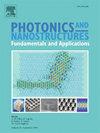混合结构中有效发光的共振模式交叉
IF 2.9
3区 物理与天体物理
Q3 MATERIALS SCIENCE, MULTIDISCIPLINARY
Photonics and Nanostructures-Fundamentals and Applications
Pub Date : 2025-09-01
DOI:10.1016/j.photonics.2025.101436
引用次数: 0
摘要
连续介质中的束缚态(bic)是具有无限辐射质量因子的特定共振模式,它是通过对称保护、参数调谐或偶然简并机制与自由空间辐射不匹配而产生的。为了利用bic在发光应用(如led和激光器)中的巨大潜力,必须将发光纳米材料与基于bic的架构有效集成。在这里,我们数值模拟了发光封盖层对等离子体-光子混合系统的影响,该系统由具有二维周期波状界面的铝衬底和阳极氧化铝光子晶体板组成。我们考虑CdSe/CdS纳米薄片(NPLs)作为增益材料,因为它们具有很高的工业应用潜力。所提出的符合束缚态形成条件的实用指南,在光谱上与NPLs的光致发光带对齐,可以进一步用于高性能溶液可加工激光器的实验实现。本文章由计算机程序翻译,如有差异,请以英文原文为准。
Resonant mode crossing in hybrid structures for effective light-emission
Bound states in the continuum (BICs) are specific resonant modes with infinite radiative quality factors that arise from a mismatch with free-space radiation through mechanisms of symmetry protection, parameter tuning, or accidental degeneracy. To harness the significant potential of BICs for light-emission applications such as LEDs and lasers, it is essential to efficiently integrate light-emitting nanomaterials with BIC-based architectures. Here, we numerically model the effect of a light-emitting capping layer on the plasmon-photonic hybrid system consisting of an aluminum substrate with a two-dimensional periodic wave-like interface to an anodic alumina photonic crystal slab. We consider CdSe/CdS nanoplatelets (NPLs) as the gain material because of their high potential for industrial applications. The proposed practical guide for compliance with the conditions for bound states formation, spectrally aligned with the photoluminescence band of the NPLs, can be further used for experimental realization in high-performance solution-processable lasers.
求助全文
通过发布文献求助,成功后即可免费获取论文全文。
去求助
来源期刊
CiteScore
5.00
自引率
3.70%
发文量
77
审稿时长
62 days
期刊介绍:
This journal establishes a dedicated channel for physicists, material scientists, chemists, engineers and computer scientists who are interested in photonics and nanostructures, and especially in research related to photonic crystals, photonic band gaps and metamaterials. The Journal sheds light on the latest developments in this growing field of science that will see the emergence of faster telecommunications and ultimately computers that use light instead of electrons to connect components.

 求助内容:
求助内容: 应助结果提醒方式:
应助结果提醒方式:


